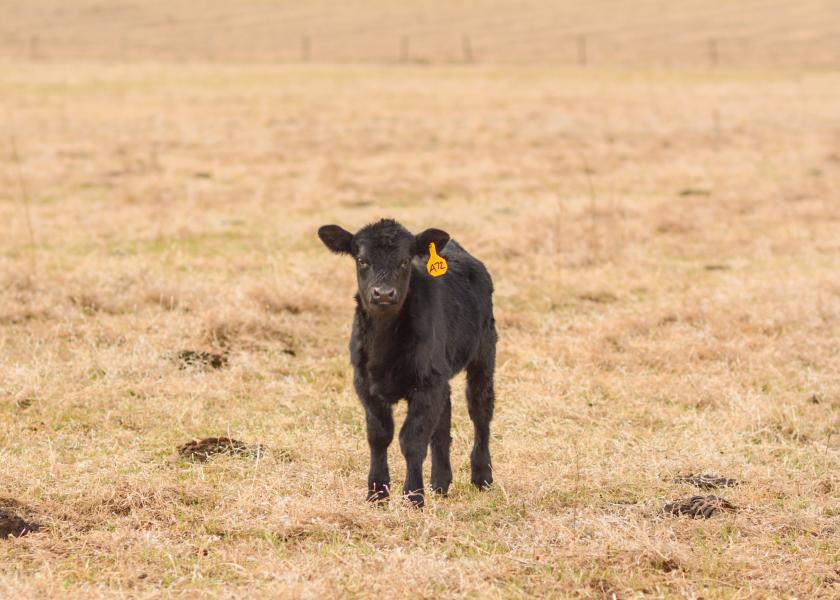Calf Scours Prevention Starts Now

Spring calving season will be upon us soon. While there are many seasonal preparations to consider before the first calf hits the ground, calf scours prevention is not always one that comes to mind.
Diarrhea, or scours, is one of the most likely reasons young beef calves become sick or die. In addition to the detriment to calf health and well-being, scours are costly to cattle producers due to poor calf performance, the expense of medications and labor to treat sick calves, and death loss, a University of Nebraska-Lincoln article explains.
While calf diarrhea is a complex disease with many interrelated causes, including the infectious agent, calf health status and environmental factors, studies show that calves typically become ill or die from diarrhea within one to two weeks of age.
“A young calf in its first week of life finds its worst enemy to be a calf that’s three to five weeks of age, from a germ standpoint,” says Bob Larson, DVM, professor of production medicine at Kansas State University. A calf between three and five weeks of age will shed more germs that can cause scours than any adult cow or an older calf (at least six weeks of age).
So, what management decisions can be made to help prevent calf scours?
A group of researchers at the University of Nebraska-Lincoln developed a system known as “The Sandhills Calving System,” which helps prevent contacts among beef calves, decreasing the transmission of pathogens causing scours.
The system includes a scheduled movement of pregnant cows to clean calving pastures to minimize pathogen dose-load in the environment and contact time between calves and the larger portion of the cow herd. This ultimately recreates the more ideal conditions that exist at the start of the calving season with each move.
How it Works
All cows are turned out on the first calving pasture at the beginning of the season. After approximately one to two weeks, the remaining pregnant cows are moved to the next pasture, while the cow-calf pairs are left on initial, first pasture. This movement continues throughout the remainder of the calving season, moving pregnant cows every one to two weeks. Cow-calf pairs from different pastures may then be commingled after the youngest calf is at least four weeks of age.
While the system makes sense, the logistics of it might seem daunting. Experts at Kansas State University (KSU) shared some of their thoughts when it comes to implementing the system.
Brian Lubbers, DVM, associate professor at KSU’s college of veterinary medicine, explains that fecal and oral disease transmission is most common, therefore, moving pregnant cows to a pasture not adjacent to the previous group is ideal. However, fenceline contact would be acceptable, as the risk of fecal and oral transmission would still be dramatically decreased.
While moving the herd at least every two weeks is ideal, Larson suggests, moving the herd as many times as possible with the available paddocks and land resources is better than no movement at all. Additionally, Lubbers suggests producers not reuse pastures, if at all possible. The goal is to keep new calves on fresh ground for the season.
So, what if there are not enough paddocks available?
“I always work backwards, depending on how many pastures I have,” says Lubbers.
Consider this scenario:
A rancher has 4 paddocks and 200 pregnant cows. In the first 21 days of the season, half of the calves (100) are born. In the next 21 days, another 25% (50) of the calves are born. The remaining 25% (50) are born after the first two breeding cycles (42-plus days).
Anticipating approximately 100 calves will be born in the first three weeks, the rancher might consider moving the pregnant cows for the first time on approximately day 10, anticipating a similar number of calves to born in the following 10 to 11 days. The rancher may then move the pregnant cows for the second time at the conclusion of the first 21-day breeding cycle. Over the next two weeks, the rancher might expect a few less than 50 calves to be born. However, to keep the calves at a similar age, the rancher should move the remaining pregnant cows to the final paddock. At this point, the disease pressure will likely be less as the calves are born over a longer period of time.
Other Considerations and Benefits
When preparing to implement the system, here’s a couple other factors to consider:
1) Size of paddocks—make sure the number of calves anticipated to be born will have sufficient space
2) Weather—consider the use of more protected or sheltered paddocks towards the beginning of the season, while more open paddocks can be used later in the spring as weather conditions improve
Along with the benefit of less disease pressure, this system may also serve as a management tool, helping ranchers keep track of the cows bred in the first cycle, compared to those that bred back in the second or third cycle.
In the next several weeks or months ahead of calving season, how might you be able to adjust your current calving system to better utilize your resources and better protect your calves?







